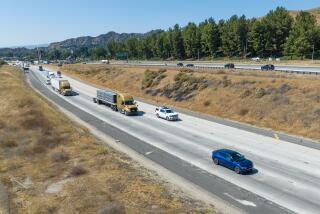Smart Food Stamp Reforms
- Share via
An outdated rule forces many food stamp applicants to choose between keeping the car that could get them to a job and qualifying for food stamps. Another food stamp regulation, requiring state officials to fingerprint every adult applicant, costs the state $11 million annually on top of the $31 million sunk into fingerprint machines -- with little payback in catching cheaters. Two proposals to alter these rules could save the state money and get food to more hungry families.
California is one of just 10 states in which an applicant must sell his or her car to qualify for food stamps if the car is worth more than the federally set ceiling of $4,650 -- the value of an 8-year-old Nissan Sentra. This Catch-22 works a particular hardship in Southern California, where job options shrink dramatically for those who must ride a bus -- or several buses -- to get to work. The rule is intended to keep con artists who cruise around town in shiny new Cadillac Escalades from abusing food stamps. But federal researchers, in a recent pilot study, found that the car most commonly driven by food stamp recipients in North Carolina, which has no car value limit, was a Ford Escort.
That’s why President Bush this year proposed exempting one vehicle per adult from the federal asset limit to qualify for food stamps. Although that proposal is stalled in Congress, states can set more generous car value limits or do away with them; most states, including Texas, have already moved in the direction of Bush’s proposal.
A bill by Assemblyman Darrell Steinberg (D-Sacramento) would do away with California’s auto exclusion, letting each adult own one car of any value, and allow about 50,000 more families to receive food stamps. Steinberg’s AB 231 is scheduled for a Senate committee hearing today. In the unlikely event that scammers show up with Lexuses to apply for food stamps, the law can and should be amended. But state officials will save money by not having to page through the Kelley Blue Book for each applicant.
The fingerprint requirement is a classic case of overkill. To catch or deter bilkers, California is spending millions on a vast, costly bureaucracy. Yet most fraud happens when legitimate recipients resell their food stamps for cash on street corners. The fingerprint rule does nothing to stop that. The funds would probably be better spent prosecuting illegal traffic in food stamps.
The proposals are not a matter of getting soft on welfare, but of making welfare reform work better. A growing number of former welfare recipients now in low-paying jobs still depend on food stamps to keep them whole, off the dole and off the streets. It’s in everyone’s interest to keep them in their jobs -- and even save the state money.
More to Read
Sign up for Essential California
The most important California stories and recommendations in your inbox every morning.
You may occasionally receive promotional content from the Los Angeles Times.












